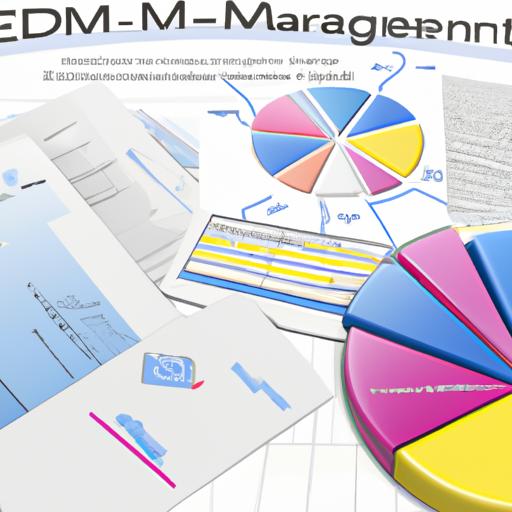As businesses continue to grow, the amount of data they accumulate also increases. With the exponential growth of data, enterprises are struggling to manage their data effectively, making it challenging to analyze and utilize the data to improve the business. This is where an enterprise data management framework comes in.
An enterprise data management framework is a structure that outlines the processes, policies, and technologies required to manage enterprise data effectively. It is a comprehensive approach that focuses on all aspects of data management, from data governance to metadata management.
Having an enterprise data management framework in place is essential for businesses that want to manage their data effectively. With a framework in place, enterprises can ensure the accuracy, consistency, and security of their data, making it easier to analyze and utilize the data to improve the business.
In this article, we will explore the key components of an enterprise data management framework, the benefits of implementing one, the best practices for implementation, and the challenges enterprises may face during implementation. So, let’s dive in and explore how an enterprise data management framework can help your business manage its data effectively.
Key Components of an Enterprise Data Management Framework

Collaborating for effective data management
To effectively manage enterprise data, an enterprise data management framework must have the following key components:
Data Governance
Data governance refers to the policies, processes, and standards that ensure that data is accurate, complete, and secure. It involves defining data ownership, establishing data quality requirements, and ensuring that data is used ethically and legally.
Data Architecture
Data architecture is the foundation of an enterprise data management framework. It involves defining the structure of data, including data models, data storage, and data flow. A well-defined data architecture makes it easier to store, manage, and analyze data effectively.
Data Integration
Data integration is the process of combining data from different sources to create a unified view of the data. It involves extracting, transforming, and loading data from various sources into a single database or data warehouse. Data integration is essential to ensure that data is consistent and up-to-date.
Data Quality Management
Data quality management involves ensuring that data is accurate, consistent, and complete. It involves defining data quality standards, monitoring data quality, and resolving data quality issues. Effective data quality management ensures that data is reliable, which is critical for making informed business decisions.
Master Data Management
Master data management involves creating a single, authoritative source of data for critical business entities such as customers, products, and suppliers. It involves defining data standards, establishing data ownership, and ensuring that master data is consistent across the enterprise.
Metadata Management
Metadata management involves managing the information about data, including data definitions, data lineage, and data relationships. Effective metadata management ensures that data is well-documented, making it easier to understand and utilize the data.
Incorporating these key components into an enterprise data management framework is essential for effectively managing enterprise data. With these components in place, enterprises can ensure that their data is accurate, complete, and secure, making it easier to analyze and utilize the data to improve the business.
Best Practices for Implementing an Enterprise Data Management Framework

Understanding the complexity of enterprise data management
Implementing an enterprise data management framework can be a complex process, but with the right approach, it can be done effectively. Here are some best practices to consider when implementing an enterprise data management framework:
Define Clear Objectives
Before implementing an enterprise data management framework, it is essential to define clear objectives. This involves identifying the business goals and the data management objectives that align with them. Having clear objectives ensures that all stakeholders are on the same page, making it easier to evaluate the success of the framework.
Establish a Data Governance Structure
Data governance is a critical component of an enterprise data management framework. It involves creating policies and procedures for managing data, ensuring that data is used ethically and appropriately. Establishing a data governance structure helps ensure that the data is accurate, consistent, and secure.
Identify Key Stakeholders
Identifying key stakeholders is crucial during the implementation of an enterprise data management framework. Key stakeholders include business leaders, IT teams, data analysts, and data users. Involving all stakeholders in the implementation process helps ensure that the framework meets the needs of the business.
Develop a Roadmap
Developing a roadmap is an essential step in implementing an enterprise data management framework. The roadmap outlines the steps required to implement the framework and the timeline for each step. It helps ensure that the implementation process is structured and organized.
Ensure Resource Availability
Implementing an enterprise data management framework requires resources, including people, technology, and funding. Ensuring that the necessary resources are available is essential for the successful implementation of the framework.
Conduct Regular Audits
Regular audits are necessary to ensure that the enterprise data management framework is working effectively. Audits help identify any issues or areas that need improvement, ensuring that the framework continues to meet the needs of the business.
Challenges to Implementing an Enterprise Data Management Framework

Managing enterprise data at scale
Implementing an enterprise data management framework is not without challenges. Enterprises may face several roadblocks that can hinder the implementation process. In this section, we will discuss some of the challenges enterprises may face during the implementation process.
Resistance to Change
One of the most significant challenges to implementing an enterprise data management framework is resistance to change. People tend to resist change, and implementing a new framework requires a significant change in the way data is managed. Employees may be resistant to changing their workflows, and management may be hesitant to allocate resources to implement the framework.
Lack of Resources
Implementing an enterprise data management framework requires resources, including personnel, technology, and budget. Enterprises may not have the necessary resources to implement the framework effectively. A lack of resources can lead to delays in implementation, poor performance, and an increased risk of failure.
Inadequate Infrastructure
Inadequate infrastructure is another challenge enterprises may face when implementing an enterprise data management framework. The framework requires a robust and reliable infrastructure to support the management of enterprise data. If the infrastructure is inadequate, it can impact the performance of the framework and lead to data quality issues.
Limited Budget
Finally, limited budget can be a significant challenge when implementing an enterprise data management framework. Enterprises may not have the necessary funds to invest in the technology, resources, and infrastructure required to implement the framework effectively. This can lead to delays in implementation, poor performance, and an increased risk of failure.
In conclusion, enterprises must be aware of the potential challenges they may face when implementing an enterprise data management framework. By identifying these challenges, they can develop strategies to overcome them and ensure the successful implementation of the framework.
Conclusion
In conclusion, an enterprise data management framework is a crucial component of any business that wants to manage its data effectively. By implementing a framework, businesses can improve the accuracy, consistency, and security of their data, making it easier to analyze and utilize the data to improve the business.
The benefits of implementing an enterprise data management framework are numerous, including improved data quality, reduced costs, increased efficiency, better decision making, and increased compliance. By adhering to the best practices outlined in this article, businesses can overcome the challenges of implementation and ensure the success of their framework.
In today’s data-driven world, managing enterprise data effectively is critical to the success of any business. By implementing an enterprise data management framework, businesses can effectively manage their data, gain insights into their operations, and make informed decisions that drive growth and success.
So, if you haven’t already, it’s time to consider implementing an enterprise data management framework in your business. With the right framework in place, you can take control of your data and unlock its full potential.